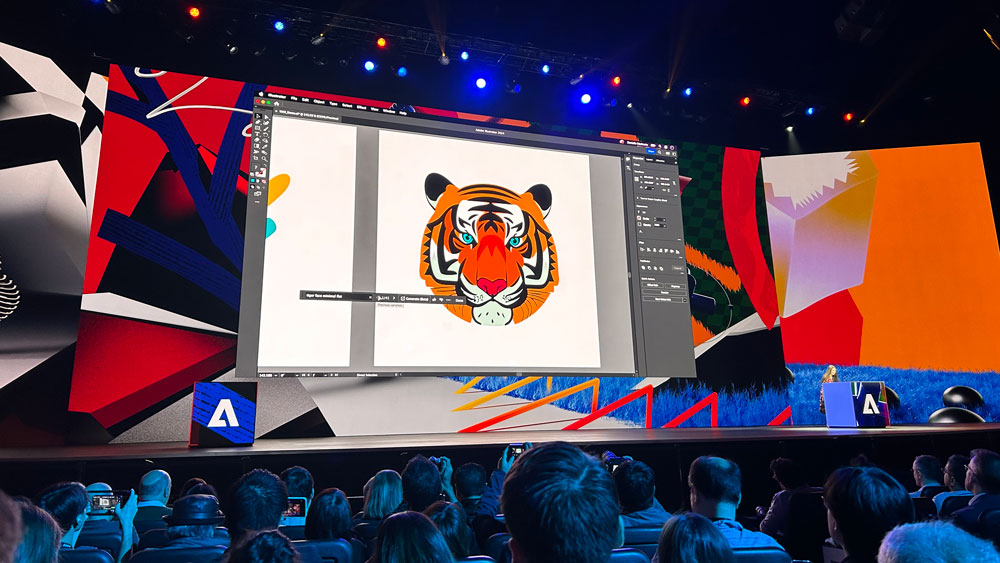"Let the robots do the work" – Adobe is unapologetically all-in on AI
I was there for the generative AI announcements at MAX and, though technologically impressive, it was a surreal experience.

"Let the robots do the work“ was the repeated refrain at Adobe Max this year – a phrase that succinctly and enthusiastically demonstrates how Adobe feels about AI, and how it can help you. The software company has a laser sharp focus on expanding its Firefly capability across the whole Creative Cloud suite, and it is unapologetic about the benefits it feels the technology will bring to creativity.
I attended the MAX conference last week when Adobe unveiled new tools for Illustrator, Express and Premiere Pro in particular, and it was a slightly surreal experience at times. It was technologically impressive, of course, but at key moments the whoops and cheers in the room were at odds with the unfolding response to some of the announcements on X (Twitter).

So what's the balanced view? Well, Adobe is basically exploring two pathways with its approach to AI tools, the first being all those tools that deal with the 'busy work'. From removing stray hairs in Photoshop to cutting out filler words from video in Premiere Pro (above – and read about those developments here), there are clear benefits to all users when AI can take on the jobs you don't want to do, and make you more efficient. This is really where the robot refrain came in – a celebration of no longer needing to complete mundane tasks.
But it's the other side that is causing concern among creative professionals – the text-to-media capability, that has now hit vectors in Illustrator and will come to video and 3D in the near future. Though the response at Max was amazement at the capabilities of the AI, there is also professional concern over whether designers and artists will be as needed in the future, and even whether Adobe is cannibalising its own consumer base. But Adobe believes AI will deliver a lot of benefit for creatives of all levels across the industry, and deliver on its brand message of 'Creativity for All'.

Adobe's message is that the world needs more visual content than ever before, and the demand will only keep growing. AI will enable this explosion of content, allowing the industries to keep up with the demand. The diverse range of AI tools will make pros and hobbyists more efficient across the board, speeding up process via both types of tools, with the text prompt technology helping with ideation and providing a baseline to work from rather than the finished product. Given all text-prompt created images are fully editable, it would be down to the skill level of the operative that determined the complexity and standard of the final product.
The comparison was made at MAX between the advent of digital art, and the concerns over what that meant for traditional painting. Both still exist now, with artists that specialise in both.
It's worth noting that Adobe is also clear that the developments have happened in conversation with their user base, and that the new tools have come from asking what creatives actually want from AI.
Daily design news, reviews, how-tos and more, as picked by the editors.

This is certainly an opportunity for Adobe to widen its consumer base from creative professionals to those who want to create content. I mean this term broadly because it is broad. It could cover anyone from a marketer to an influencer, all of whom are now empowered to create high-quality content without the need for digital art or graphic design skills.
Amazing news for all those content creators, of course (and, cynically, a great opportunity for Adobe as a business), but the impact on designers and artists is, as yet, unmeasured. Though this new focus will welcome new customers, will it be at the cost of the old ones – or will there be space for both?

There's also the question of the value of the skills designers and artists have curated. If no consumer can tell the difference between AI-created media and design created the old fashioned way, is the work of a traditional designer or digital artist lessened in the space? If the colours in your design are chosen by generative recolor, does that devalue the skillset needed to choose colour?
Whatever the answer, Adobe is seeking to progress with empathy, taking steps such as promising to pay the legal bills of business customers using Firefly, if they encounter infringement situations. But the message is clear, AI is going to be firmly embedded from now on. See the Max Sneaks from this year right here for what exactly could be coming up in the future.
I talked to senior execs at Adobe about some of the questions and issues raised in this post – watch out for the full interviews, which will go live in the next couple of days.

Georgia has worked on Creative Bloq since 2018, and has been the site's Editor since 2023. With a specialism in branding and design, Georgia is also Programme Director of CB's award scheme – the Brand Impact Awards. As well as immersing herself with the industry through attending events like Adobe Max and the D&AD Awards and steering the site's content streams, Georgia has an eye on new commercial opportunities and ensuring they reflect the needs and interests of creatives.
